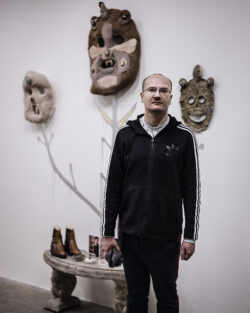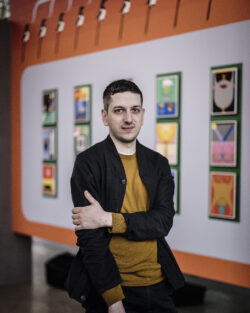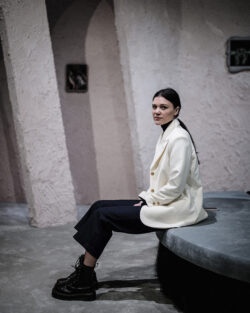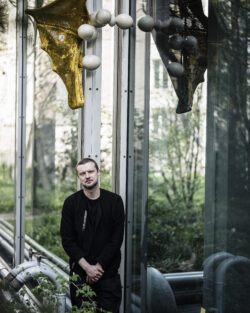Metamorphosis. Art in Europe Now presents 21 artists from 16 countries, working in different media: painting, sculpture, fashion, design, and film.

Gabriel Abrantes (Portugal)
Born in 1984, in North Carolina, United States, he lives and works in Lisbon.
Gabriel Abrantes writes, directs and often acts in films that explore gender and identity issues and shatter historical assumptions and traditional politics. Although many of his films humorously revisit the works of the major figures of European culture such as Édouard Manet, William Shakespeare or the great Portuguese poet Luís de Camões, Gabriel Abrantes also explores contemporary crises and global pop culture. His first feature film, Diamantino, portrays a star football player, a hero in Portugal, whose athletic brilliance ends the day he finds himself confronted with the arrival of migrants near his yacht, and on whom the government decides to perform parallel cloning experiments. In A Brief History of Princess X, Gabriel Abrantes tells the story of the creation of Princess X, a work of the Romanian sculptor Constantin Brâncuși that portrays Princess Marie Bonaparte, Napoleon’s great-grand niece (and a pioneer of psychoanalysis), in the form of a male phallus. This film is a reflectionon the meaning of artistic creation and the power struggle between the sexes.

Magnus Andersen (Denmark)
Born in 1987, in Elsinore, Denmark, he lives and works in Brussels.
The subject of education is central to the work of Magnus Andersen, who is interested in the values that unite us and which are transmitted to younger generations. In his Regional Education series, young people on the threshold of adulthood seem to be reflecting deeply on their place in society and the role that they will soon have to play. A variation on two paintings by British artists Joshua Reynolds and Thomas Gainsborough, renowned 18th-century portrait and landscape painters, Regional Education echoes the theories developed a century earlier by British philosopher John Locke on the innate nature of certain skills in children and the crucial role of education. In reference to the current events of the European Union, Magnus Andersen gives the role of adult educator to Martin Selmayr, the European Commission’s current Secretary-General. Regional Education also includes a sound work presented at the exhibition’s entrance. Taking the form of a multilingual collage, it involves a group of children chanting excerpts from European treaties, free-trade agreements, and national anthems, evoking not only the world of choirs and summer camps, but also of hooliganism and team-building exercises.

Evgeny Antufiev (Russia)
Born in 1986, in Kyzyl, Russia, he lives and works in Moscow.
Evgeny Antufiev was born in the Tyva Republic, an autonomous republic of the Russian Federation, at the southern most tip of Siberia. This territory, bordering on Mongolia, was formerly at the crossroads of nomadic routes, particularly those used by the Scythians. As a child, Evgeny Antufiev visited the museumin Kyzyl, the capital city of Tyva, which was created only a century ago. There, he discovered the precious vestiges of this glorious ancient civilization and was profoundly impressed. His artistic practice is inspired by the civilizations and great figures of the past: Leo Tolstoy, the Etruscan kings, the ballerina Anna Pavlova, Yves Saint Laurent, and Ramses II are all part of the same eternity, despite the time periods separating them. His sculptures and works in wood, bronze, stone, textile, bone, and ceramic explore recurring primordial forms, such as those used for making knives, vases, and masks. Lured by the solitude and serenity of places of worship, Evgeny Antufiev designs his installations, such as the one created especially for this exhibition, according to a floor plan reminiscent of a temple or mausoleum.

Charlie Billingham (United Kingdom)
Born in 1984, in London, where he lives and works.
Artist Charlie Billingham draws inspiration from the drawings, prints, and etchings produced in Regency-era in England, at the end of the 18th-century. This period of uncertainty was marked by major social upheavals in Europe. At the time, many artists such as James Gillray and George Cruikshank began making caricatures of the aristocracy, which had become dissolute and disconnected from reality. Charlie Billingham crops, enlarges, and distorts these caricatures, taking them out of their original political and social context to create new compositions. The installation created specifically for the Fondation Cartier includes paintings in various formats, affixed to a mural painting realized manually using the technique of foam stamp printing. He also includes decorative objects such as vases and folding screens to make his installation feel like a domestic environment. In this work, Charlie Billingham casts a satirical eye on the vanity of male nobility and on the futile and frivolous social games of yesterday and today.

Kasper Bosmans (Belgium)
Born in 1990 in Lommel, Belgium, he lives and works in Amsterdam and Brussels.
Fascinated by the history and the origin of symbols, Kasper Bosmans extensively researches the folklore, traditions, legends, and anecdotes, from his native Belgium as well as from around the world and revives this material in his work in the form of sculptures and installations. Kasper Bosmans has been developing, since 2013, a series titled Legend Paintings [Peintures de légende], which borrows from the Internet, social media, and heraldic symbolism. Each work is composed of three wooden panels in a fixed format that combine drawing and painting to create a rebus to be deciphered by the viewer. Five triptychs are presented here, including one specifically created for the exhibition. His paintings deal with issues such as identity, migration, and ecology and use history to talk about today’s world.

Formafantasma (Italy)
Formafantasma is a design studio based in Amsterdam created by Andrea Trimarchi (born in 1983, in Bolzano, Italy) and Simone Farresin (born in 1980, in Malo, Italy).
For the Ore Streams project, the Formafantasma duo (Andrea Trimarchi and Simone Farresin) focused on electronic waste as an essential resource for the near future: by around 2080, most raw materials used to create metal devices will come from recycling rather than from underground mining. They conducted a detailed investigation with researchers, companies specializing in electronics, recycling specialists, and NGOs, trying to apply the same rationale to the use of this waste as that applied by industry giants in the production of their goods. The result of this investigation is a line of office furniture, far from the image usually associated with recycling. A careful scrutiny of these pieces reveals recovered objects, such as a microwave grid, cell-phone cases, or a piece of salvaged gold. Alongside the furniture, Formafantasma shows a group of videos that provide a synopsis of their research, for the general public and industrialists. Three videos are presented in this exhibition: Disassembling shows the dismantling of all the components in several electronic objects; Taxonomy depict their classification; and Animation, in the form of a 3D animation, shows several possible strategies to facilitate the recovery of these resources in the future.

Benjamin Graindorge (France)
Born in 1980, in Paris, where he lives and works.
After graduating from ENSCI – Les Ateliers in 2006, he won the Cinna competition and the Audi Talents Awards consecutively in the design category. After a residency at the Villa Kujoyama in Kyoto, he returned to France to collaborate on the scenography of the Biennale Internationale Design Saint-Étienne (2010). Since 2009, he has collaborated with the studio YMER&MALTA. Together, they have strived to expand the limits of forms and techniques by combining traditional materials and know-how with new technologies. In 2018, he exhibited a series of pieces, the fruits of this joint research, at the Château Borély in Marseille.
The exhibition designer Benjamin Graindorge presents three works in the exhibition. In order to create his objects, the designer begins by drawing abstract, colored shapes on paper. He refers to these preparatory sketches as “drawings of emotion.” His designs combine cutting-edge digital technologies with traditional crafts such as marquetry, ceramic or glass work. He thus uses 18th-century decorative art techniques to create simple forms that are inspired by nature, yet free of superfluous ornament. This can beseen in the works presented in the exhibition: the edaLight, the asphericalSkylight, and mirrorMirage.

Miryam Haddad (Syria)
Born in 1991 in Damascus, Syria, she has lived in France since 2012.
Miryam Haddad was born and raised in Damascus, Syria and arrived in France in 2012 to study at the École des Beaux-Arts de Paris. The scenes depicted in her paintings seem to come from fairytales and legends because they often represent archetypal figures such as kings, witches or scarecrows, but in fact they come entirely from the artist’s imagination. Despite the vivid colors of her canvases and the exuberant positions ofthe figures she represents, her paintings reveala dark reality. Fragments of stained glass or ceramic placed on the surface of the paintings seem to open up to another reality—a tragic comedy—that is suggested by their eloquent titles. The paintings are occasionally structured by arcades, colonnades, replicas of antique statues, or other architectural features that can be found in the Syrian landscape and are currently endangered by war. The artist works in both large and very small formats, encouraging the viewer to look closely at the paintings in order to better apprehend their composition.

Klára Hosnedlová (Czech Republic)
Born in 1990 in Uherské Hradiště, Czech Republic, she lives and works in Berlin.
Interested in the history of arts and crafts, Klára Hosnedlová gave up her practice of painting to focus on weaving and embroidery and their relationship to domestic space and decoration. Inspired by architect and fellow Moravian Adolf Loos’s (1870-1933) reflection on the need to free architecture of excessive ornamentation, she seeks to create harmonious spaces by using high quality materials and fabrics in her wall paintings and embroidered furniture, clothing, and portraits. Her portraits, which she views as paintings, and for which she herself makes the ceramic frames, are created from details of photographs taken inside the installations using live models. For this exhibition, she has created a work that resembles a stage set–an intimate, feminine room that includes costumes from thecollections of the National Theatre in Prague.

Nika Kutateladze (Georgie)
Born in 1989, in Tbilisi, where he lives and works.
The projects of Nika Kutateladze explore how architectural space can reveal individual and collective memories. For this exhibition, the artist has brought an abandoned house from his family’s native village in the region of Guria, Georgia, confronting it with Jean Nouvel’s building. Deconstructed by the artist, the house traveled by truck through six countries before getting to the Fondation Cartier. By taking this house out of its original setting and placing it in a new context, the artist strives to show the consequences of the rural exodus that hit his country in the early 90s. Far from being simply an exercise in replication, the reconstruction of this house in a gallery space is a poetic attempt to bring to life the memories of a household, a village, and a country.

Piotr Łakomy (Poland)
Born in 1983, in Skwierzyna, Poland, he lives and works in Poznań.
The work of Piotr Łakomy explores the relationship of sculpture to the human body, architecture, and the environment. Influenced by the rationalism of Le Corbusier and the biomorphism of Frederick Kiesler, the artist uses both organic and industrial materials in his work. For the Fondation Cartier, he has created a sculpture that plays with the transparency of Jean Nouvel’s building. Composed of two elements mounted discreetly in a corner, the sculpture appears to grow from the inside of the gallery out into the garden. These two segments have the same underlying metallic structures based on the dimensions of Le Cobusier’s Modulor, an anthropometric scale of proportions used for the design of architectural elements. Over these structures, the artist has folded panels of aluminum honeycomb—a material used in the aerospace and construction industries—in a way that suggests a natural formation. By including ostrich eggs in his work, the artist refers to the sphere as a fundamental architectural form and as a shelter for life.

Lap-See Lam (Sweden)
Born in 1990, in Stockholm, where she lives and works.
In her art, Lap-See Lam examines the ambiguity of identity and cultural constructs through an exploration, similar to archaeology, of the history of the Chinese diaspora in Sweden. Originally designed as a mobile phone application, Mother’s Tongue is a work produced in tandem with her cousin, the director Wingyee Wu. Using a 3D scanner, the artist started out by recording the interior of several Chinese restaurants in Stockholm, at a time when many of them are about to disappear. This initial act of preservation is then fictionalized by way of a voice-over. Besides the ghost of the restaurants addressing the viewer from a future where artificial intelligence and robotics seem to have replaced the places and the people, monologues by three women are heard who have a history with these restaurants; three generations that successively evoke the cultural frictions, family-related, social as well as technological,that they are confronted with. Using specific stories, the film evokes the cultural reality of immigration and how it affects the construction of identity and otherness over time.

Kostas Lambridis (Greece)
Born in 1988, in Athens, where he lives and works.
With The Elemental Cabinet, his graduation project, Kostas Lambridis makes a bold entrance into the world of design. A reinterpretation of the Badminton Cabinet, a marvel of 18th-century Florentine decorative art renowned for the extreme sophistication of its ornamentation and the richness of its materials, this work also pays homage to Robert Rauschenberg’s Elemental Paintings, which combine, without any sense of hierarchy, precious (gold leaf) and poor (soil, grass, paper tissues) materials. Kostas Lambridis juxtaposes these opposing concepts of the value of materials, using all the resources at his disposal (3D printing, blown glass, marquetry, plastic, concrete...) to copy what he considers “a perfect example of sublime vanity.” The two other works presented here, which come from the same series and have been created for the exhibition, continue the exploratory work of archetypal furniture pieces that embody the richness and elitism of the baroque period. Based on this re-appropriation of known forms, through composite sources, The Elemental Daybed draws its inspiration from baroque chaise longues, contemporary designer daybeds and thermoformed chairs, while The Elemental Chandelier, with its different light sources combined in a sphere, takes the shape of a sun.

Kris Lemsalu (Estonia)
Born in 1985, in Tallinn, where she lives and works.
Through sculptural installations, performances, and photographic self-portraits, Kris Lemsalu forcefully and ironically explores the existential questions that govern life such as birth and death as well as other issues such as beauty, repulsion, gender, and our relationship to the animal world. The ceramics she makes on the island of Hiiumaa, off the coast of western Estonia, are a central part of her practice. The beings she represents—animals, humans, or hybrids—appear both fragile and immutable; their bodies are fragmented yet seem to be in movement. She refutes any hierarchy of materials: the delicacy of porcelain is associated with natural materials and found objects such as blankets, clothes, blue balloons, a Soviet-era fishing boat, and rope.

George Rouy (United Kingdom)
Born in 1994, in Sittingbourne, United Kingdom, he works and lives in Kent.
George Rouy paints hybrid figures that seem to float timelessly in a field of color. He is inspired by the dream-like quality he sees in the work of late medieval artists such as Jean Fouquet and Rogier van der Weyden, but is also influenced by modern artists of the first half of the 20th-century in the way he represents the human body. His sensual and ambiguous paintings depict individuals of often indeterminate gender whose bodies, identities, and gestures seem to coalesce into one. Their eyes, looking head on or slightly askance, can seem mocking or gentle. He uses Photoshop to prepare his compositions in order to break with the automatic reflexes of manual drawing, and is influenced by the color tools offered by this software in the way he applies paint to the canvas. His subtle, blended variations of tone and color are the result of a delicate and meticulous application of layers of paint with very fine brushes, which gives his paintings an evanescent quality.

John Skoog (Sweden)
Born in 1985, in Kvidinge, Sweden, he lives and works in Copenhagen.
Trained as a visual artist at the Städelschule in Frankfurt, Germany, artist John Skoog nowmakes films, which he presents in exhibitionspaces and theaters, and is currently workingon his first cinematic feature film. His work focuses on human communities by exploring their intimate and shared experiences, the irritualistic or poetic projections. For the 2014 film Shadowland, John Skoog set out to locate the landscapes of the American West that the studios of Hollywood’s Golden Age used to portray foreign landscapes such as the French Alps, the Sudanese desert, and Wales. For the film Federsee, presented in this exhibition, John Skoog examines the Fasnet carnival, a ritual still prevalent in various forms today in many parts of Europe that celebrates the coming of spring by chasing away the demons of winter. Shot in the state of Baden-Württemberg in southern Germany, the film follows the inhabitants of the city of Bad Buchau, who are dressed in animal or plant-inspired costumes. Though made with documentary material, the film is primarilya poetic evocation of the celebration of Fasnet, a contemporary reenactment of medieval rituals.

Tenant of Culture (Netherlands)
Born in 1990 in Arnhem, Netherlands, she lives and works in London.
Hendrickje Schimmel has named her artistic practice Tenant of Culture, a concept she borrowed from Michel de Certeau’s The Practice of Everyday Life (1984) and that refers to herposition as a cultural post-producer rather than a creator of autonomous artworks. Referencing the retail environment, her work explores how consumer trends, fashion magazines, and social media affect the way we dress, and what in turn this says about our society. Concerned by overproduction and waste in our society, she seeks to give a new life to garments she finds in the streets, in second-hand shops and around the house. She chooses clothes that are visibly used, stained or faded and that often include matter that is considered low in the aesthetic hierarchy and repulsive such as mud or dirt. By combining a variety of items and using patchwork techniques, she creates hybrid garments that express trends she has called “Ornamental Survivalism” and“Pastoral Nostalgia,” thus revealing the ambiguous marketing strategies that underpin the fashion industry.

Alexandros Vasmoulakis (Greece)
Born in 1980 in Athens, Greece, he lives and works between Athens, London, and Kythnos.
Alexandros Vasmoulakis has worked in a variety of techniques, creating sculptural installations with found objects, street murals, paintings, and collages. For his project at the Fondation Cartier, he has composed a large-scale collage using his own hand-made wallpaper on which he has hung individual paintings. The artist firstmakes a rendering on the computer, then paints on the wallpaper. Improvisation plays an essential role in his artistic process; he cuts, pastes and layers the wallpaper, working on site, so that the final piece differs considerably from the original renderings. His richly orchestrated collage combines loosely executed organic forms, triangular motifs and solid swaths of vibrant color interrupted by torn-out patches of white that give the impression of a gracefully-aged and weathered wall. Composing his work to incite the phenomenon of pareidolia, he encourages the viewer to find recognizable forms in what seems to be a purely abstract composition.

Marion Verboom (France)
Born in 1983, in Nantes, France, she lives and works in Paris.
The sculptor Marion Verboom poetically explores the evolution of forms through the study of geology, sculpture, and architecture, often relating human objects to natural ones. Her Achronies, some of which have been made specifically for the exhibition, are columns made of sculptural elements inspired by the architectural ornaments of prehistoric megaliths, Egyptian pyramids, Gothic cathedrals, and Inca temples. She casts her sculptures using resin, brass, bronze, plaster, cement, incorporating a variety of colors directly into the materials. Combining elements that come from different styles and regions, she creates a vocabulary of forms through which she imagines a new history of the world. Marion Verboom also presents two other pieces in the exhibition: a fresco that includes a work by Tenant of Culture and a cast of fruit and vegetables in resin and iron powder titled Cornucopia.

Jonathan Vinel (France)
Born in 1988, in Toulouse, France, he lives and works in Paris.
A filmmaker from southwestern France, Jonathan Vinel is the author of numerous short fiction films, made with Caroline Poggi. Their first feature, Jessica Forever (2019), is a portrait of a group of orphaned and criminal boys. The relationship between these children and the ideology that unites them is unclear. They are taken in by Jessica, who is inspired by the character of Quiet in the video game Metal Gear Solid V, and is both adoptive mother and protective goddess of this reconstituted family. As in their previous films, the question of community is key. Jonathan Vinel has also made several short films alone, including somethat use images from virtual realms. In his work, heavily influenced by his use of video games, any image is as good as any other, and must be judged by the emotions it procures. The film Martin Pleure, presented in the exhibition, is produced from sequences made for the video game Grand Theft Auto V. Using his filmmaking vocabulary, Jonathan Vinel tells the story of Martin, a lonely young man, whose friends have suddenly all disappeared. Oscillating between rage and passion, Martin goes desperately looking for them in every corner of the city and gradually drifts into madness.

Raphaela Vogel (Germany)
Born in 1988, in Nuremberg, Germany, she lives and works in Berlin.
Raphaela Vogel combines sculpture, sound, video, and found objects in installations that often feature the artist as a protagonist. Drawing inspiration from areas as diverse as feminist theory, animal studies, mythology, and symbolism, her installations derive their meaning through a play of associations. She has brought together here a sculpture entitled In festen Händen III and several animal-hide paintings, made from pieces of leftover leather fabric, painted and marked in a gestural manner. The sculpture was cast from two bronze lions made by a 19th-century German artist. Its title comes from a German colloquialism for “being in a romantic relationship” which the artist sees as a metaphorfor our conflicting desires for freedom and security. Symbolizing power and might, the lions appear to be fighting with the foursnakes placed underneath them, yet are reduced to skeletal contours. As one approaches, the artist can be heard singing Hurra, wir leben noch [We are still Alive], a song originally recorded for Die wilden Fünfziger [The Wild Fifties], a film about a man who made his fortune, then went bankrupt in the years following WWII. This work explores the opposing dynamics of force and fragility, dependency and independence, courage and despair.
Photos: © Édouard Caupeil, 2019.
Except Kris Lemsalu and Raphaela Vogel, photo: © Rebekka Deubner, 2019.
